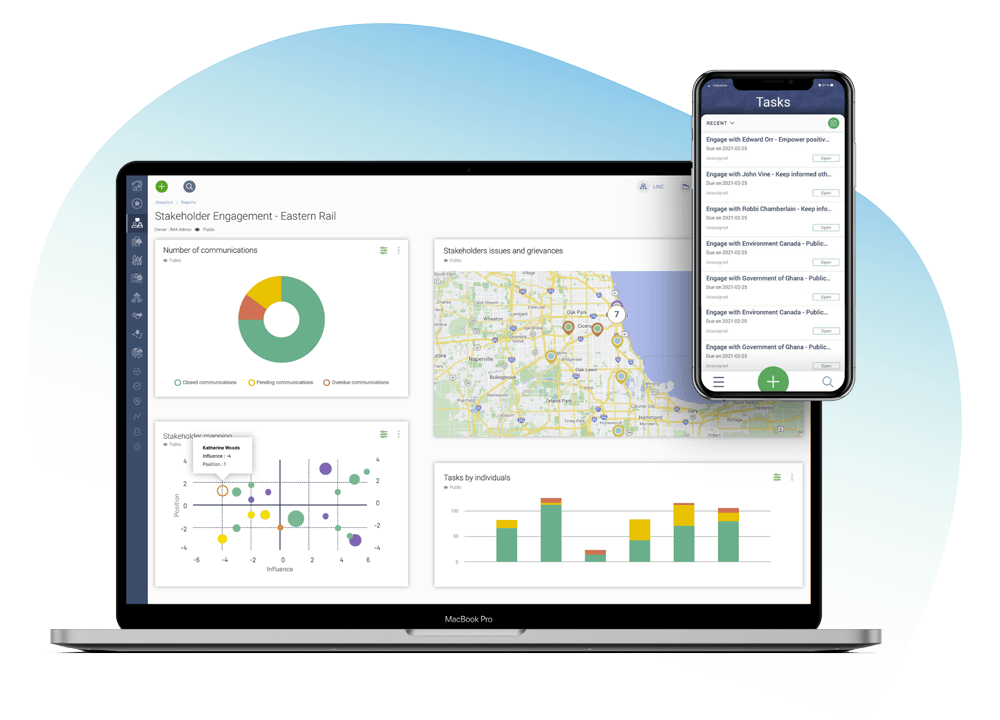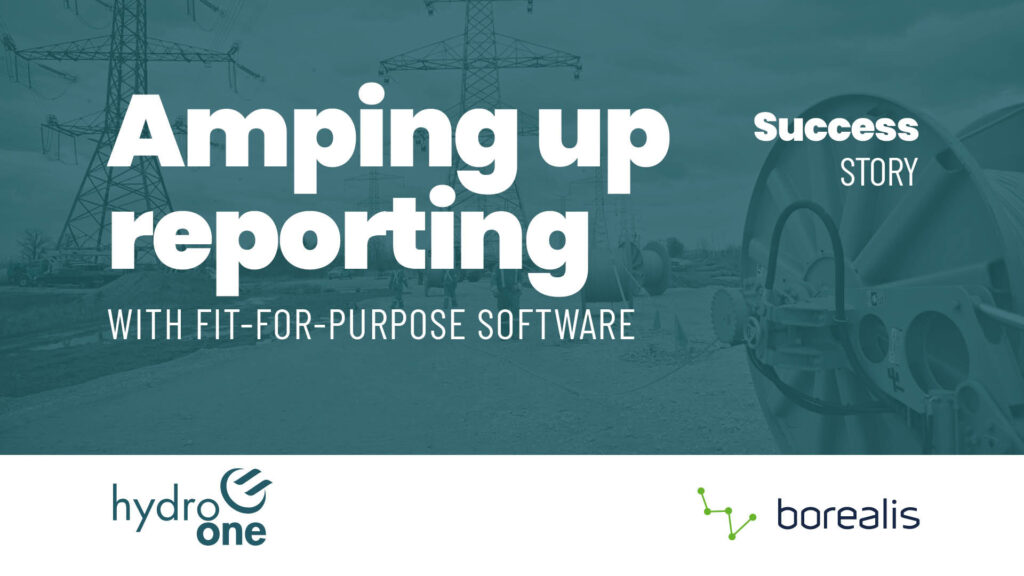As our global demand for energy is growing, public utilities have been taking more and more importance. Utilities touch lives in profound ways. From the water that nourishes populations to the power that charges individual and industrial devices, public utilities keep the world running. Their operations, decisions, and financial matters directly impact communities, making stakeholder management in this sector a critical endeavor.
This in-depth guide will help anyone in the energy & utilities sector better understand key stakeholders in the energy sector so that they can manage expectations and relationships more effectively.
Who are the stakeholders in the energy and public utilities sector?
“Stakeholders” isn’t just a corporate buzzword. The term refers to the individuals, groups, or entities who can affect – or be affected by – an organization’s actions. In the energy and public utilities’ context, this could mean customers, regulatory agencies, shareholders, and even the environment, each with their own vested interests in the industry’s activities and outcomes. Understanding the complex interplay of these varied interests can be especially challenging for teams working in community outreach, indigenous relations, public and government affairs, and other related areas of stakeholder management.
The most successful teams use stakeholder engagement software tailored for the energy & utilities sector.
See how implementing Borealis software has helped Hydro One efficiently prepare environmental assessments, manage consultations with Indigenous communities, and facilitate reporting.
Key regulatory principles governing energy & public utilities
To understand the importance of stakeholders and the role they can play in the success of an energy provider or a water utility, it’s crucial to understand the regulatory environment you might be facing.
Public utilities, energy, and water companies juggle many responsibilities. To ensure they serve the public interest, they typically follow some, or all, of the following principles to guide their engagement practices. In some cases, depending on the country or region where a company is operating, those principles can even be regulated.
Transparency
Public hearings
Notice requirements
Consumer protection
Stakeholder engagement plans
In some jurisdictions, utilities may be required to have a stakeholder engagement plan, which lays out how the utility will communicate with and involve stakeholders in various processes.
Regulatory oversight
Environmental and social impact
Before undertaking significant projects, utilities may be required to conduct environmental and social impact assessments. This ensures that any adverse impacts on stakeholders and the environment are identified and mitigated.
Access to information
Responsiveness
Utilities may be mandated to respond to stakeholder queries or complaints within a specified timeframe. Some states or provinces even ask for a complete, thoroughly documented process for complaint management or official grievance mechanisms. Sometimes, the obligation to provide anonymous ways to file a complaint is also mandatory.
Emergency preparedness
Given the essential nature of public utilities, there are often regulations that dictate how utilities should communicate with stakeholders in the event of emergencies or service interruptions. One example is the standards enforced by the Federal Energy Regulatory Commission (FERC). The North American Electric Reliability Corporation’s (NERC) reliability standards include requirements for utility companies to have adequate emergency preparedness and response plans in place. For example, NERC’s EOP-005-3 standard requires responsible entities to develop, maintain, and implement a systematic approach to restore electric power following a blackout.
Ethical considerations
Utilities can be held to certain ethical standards, especially when dealing with vulnerable or marginalized stakeholder groups. Environmental justice areas and First Nations might need some special attention, for example.
Data privacy and security
With the increasing digitization of utility operations, standards and regulations have been put in place to ensure companies take the necessary actions to ensure stakeholder data is handled securely and kept private. GDRP, Law 25 in Quebec and Privacy Act in Australia are just a few that energy and public utilities face.
Detailed analysis of the key stakeholders in the energy sector and examples
Given the diverse and sometimes conflicting interests of stakeholders in the energy sector, conducting an analysis of key stakeholder groups is essential to understand which messages will resonate best with each group.
Each key stakeholder group has the power to shape, challenge, or support the decisions an energy company makes, to varying degrees. Below is a detailed analysis of the key stakeholder groups in the energy sector. This analysis also applies to public utility companies.
Customers in the energy sector - Role, interests and influence
Role: Consume energy services, whether it’s for heating, lighting, or industrial purposes.
Interests: Reliable and uninterrupted service, competitive pricing, clean and sustainable energy sources, and transparent billing.
Influence: By driving demand.
Real-world example how customer analysis have informed decision-making in the energy sector
- Growing consumer demand for green energy has led companies like Apple and Google to invest in renewable energy sources to power their operations.
Investors and shareholders in the energy sector role, interests and influence
Role: Provide capital and funding to energy companies.
Interests: Return on investment, company growth, long-term sustainability, and sound risk management.
Influence: Through funding and investment priorities.
Real-world example how investor and shareholder analysis has informed decision-making in the energy sector
- In recent years, BlackRock and other institutional investors have emphasized the importance of environmental, social, and governance (ESG) principles. This has pushed energy companies to adopt sustainable practices.
Employees in the energy sector - Role, interests and influence
Role: Work in various capacities in energy firms, from field engineers to management.
Interests: Job security, fair compensation, safe working conditions, and opportunities for career progression.
Influence: By directly impacting daily operations.
Real-world examples how employee analysis has informed decision-making in the energy sector
Regulatory authorities in the energy sector - Role, interests and influence
Role: Set, monitor, and enforce standards, rules, and regulations for the energy sector.
Interests: Compliance with laws, consumer protection, safety standards, environmental conservation, and overall sector stability.
Influence: Through regulations and standards.
Real-world examples how regulatory authority analysis has informed decision-making in the energy sector
- The U.S. Environmental Protection Agency’s (EPA) regulations on coal-burning plants have led many utilities to retire older plants and invest in cleaner technologies.
- The U.S. EPA’s Clean Water Act sets wastewater standards, impacting the operations of all U.S. water utilities.
- The California Public Utilities Commission, a public entity, made rulings in response to extensive wildfires that influenced how public power utilities manage vegetation around power lines.
Local and national governments in the energy sector - Role, interests and influence
Role: Govern policy-making, taxation, and in some cases, ownership of public energy utilities.
Interests: National energy security, economic growth, job creation, environmental stewardship, and public welfare.
Influence: Through policy-making.
Real-world examples how local and national government analysis has informed decision-making in the energy sector
- Germany’s Energiewende policy promotes renewable energy, energy efficiency, and reduced carbon emissions. This policy is driving German energy companies towards sustainable solutions.
- Singapore’s government initiated the NEWater project, a significant strategy for water reuse.
- The UK government’s decision to renationalize rail services will drastically reshape the strategies and operations of public rail utilities.
Suppliers and vendors in the energy sector - Role, interests and influence
Role: Provide equipment, services, technology, and other resources to energy companies.
Interests: Steady business relationships, timely payments, and potential for long-term contracts and partnerships.
Influence: By introducing new technologies.
Real-world examples how supplier and vendor analysis has informed decision-making in the energy sector
- Siemens, a major supplier of wind turbines, has influenced the adoption of wind energy by many utilities worldwide.
- Companies like GE Water introduce advanced water treatment technologies that utilities adopt for better efficiency.
- The public utility of Cape Town collaborated with desalination plant providers during a severe drought to ensure continued water supply.
- Adoption of smart meters by public electricity utilities worldwide is a direct influence of tech providers aiming to enhance energy consumption efficiency.
Non-governmental organizations (NGOs) in the energy sector - Role, interests and influence
Role: Advocacy, research, and sometimes direct intervention in areas of societal concern related to energy.
Interests: Social justice, environmental conservation, sustainable development, and consumer rights.
Influence: Through advocacy.
Real-world examples how NGO analysis has informed decision-making in the energy sector
- Greenpeace’s campaigns against Arctic drilling influenced companies like Shell to reconsider their Arctic exploration plans.
- The Natural Resources Defense Council (NRDC) has influenced utilities in the U.S. to prioritize conservation and sustainable water sourcing.
- Public protests against electricity rate hikes in Delhi led the Delhi Electricity Regulatory Commission (a public entity) to reevaluate its tariffs.
Research and academic institutions in the energy sector - Role, interests and influence
Role: Conduct research, develop new technologies, and provide education and training.
Interests: Scientific discovery, collaboration with industry for practical applications, funding for research, and policy influence.
Influence: By driving innovation.
Real-world examples how research and academic institution analysis has informed decision-making in the energy sector
- Research at institutions like MIT on fusion energy has the potential to shape the future strategies of energy companies.
- Research at Stanford on wastewater treatment led to the development of more efficient purification techniques.
Media in the energy sector - Role, interests and influence
Role: Report on and analyze the energy sector, shaping public perceptions.
Interests: Access to information, transparency from energy companies, and providing timely news to the public.
Influence: By shaping public perception.
Real-world examples how media analysis has informed decision-making in the energy sector
- The documentary Gasland brought public attention to the potential environmental impacts of hydraulic fracturing. This has changed the narrative around natural gas exploration.
- Media coverage of the Day Zero water crisis in Cape Town spurred accelerated government action and public water-saving initiatives.
Competitors in the energy sector - Role, interests and influence
Role: Other companies operating within the energy sector.
Interests: Market share, competitive advantage, industry trends, and regulatory landscape.
Influence: By driving adaptation and change.
Real-world examples how competitor analysis has informed decision-making in the energy sector
- Tesla’s foray into renewable energy storage has led traditional energy companies to explore similar solutions.
- The introduction of renewable energy by certain public utilities influences other regional public utilities to adjust their energy mix to remain competitive and sustainable.
Environmental groups in the energy sector - Role, interests and influence
Role: Advocate for environmental conservation and sustainable practices.
Interests: Reducing the carbon footprint, promoting renewable energy, conservation of biodiversity, and protection of natural habitats.
Influence: By advocating for sustainability.
Real-world examples how environmental group analysis has informed decision-making in the energy sector
- The Sierra Club’s “Beyond Coal” campaign has pressured utilities to transition away from coal-fired power plants.
- Greenpeace’s campaigns influenced many public European utilities to reconsider nuclear energy after the Fukushima disaster.
Indigenous and tribal groups in the energy sector - Role, interests and influence
Role: Represent communities with cultural, ancestral, or legal ties to lands used or affected by energy projects.
Interests: Protection of ancestral lands, preservation of cultural heritage, environmental stewardship, and fair compensation or benefits from projects.
Influence: By shaping operations and partnerships.
Real-world examples how indigenous and tribal group analysis has informed decision-making in the energy sector
- Protests by the Standing Rock Sioux Tribe against the Dakota Access Pipeline brought attention to indigenous rights and environmental concerns.
- The Navajo Nation in the U.S. has influenced decisions related to water rights and access in the Colorado River Basin.
- In Canada, First Nations’ concerns have impacted public utility projects, particularly in the energy and water sectors, prompting more inclusive decision-making processes.
Financiers and lenders in the energy sector - Role, interests and influence
Role: Provide loans or financial backing to energy projects or companies.
Interests: Return on investment, project feasibility, risk assessment, and financial stability of borrowers.
Influence: By impacting project viability.
Real-world examples how lender analysis has informed decision-making in the energy sector
- The decision of Australia’s major banks not to fund coal projects in the country’s Galilee Basin impacted the project’s feasibility.
- The World Bank’s financing of water projects around the globe often comes with stipulations for sustainability and efficiency.
- Municipal bonds issued for public water utilities in New York affect the strategies and projects these utilities prioritize.
Trade unions in the energy sector - Role, interests and influence
Role: Represent the rights and interests of workers in the energy sector.
Interests: Fair wages, job security, worker safety, and representation in decision-making processes.
Influence: By impacting workforce strategies.
Real-world example how trade union analysis has informed decision-making in the energy sector
- Strikes by unionized workers at nuclear power plants in France led to significant power supply disruptions. This has brought about a call for more effective labor relations.
- Trade unions in France have historically influenced public water utility management and operations, affecting privatization decisions.
- The Transport Workers Union in New York City has influenced decisions regarding employee conditions, wages, and operations at the Metropolitan Transportation Authority, a public entity.
Trade and industry associations in the energy sector - Role, interests and influence
Role: Represent the collective interests of energy companies or professionals.
Interests: Favorable regulatory conditions, industry growth, research and development, and networking opportunities.
Influence: By impacting operations and strategies.
Real-world example how trade and industry associations analysis has informed decision-making in the energy sector
- The World Nuclear Association’s promotion of nuclear energy standards and research has influenced the operations of nuclear energy companies globally.
Key takeaways of stakeholders in the energy sector
Stakeholders in the energy and utilities sector are incredibly diverse and so are their interests.
Stakeholders directly shape strategies and daily operations. Understanding their respective roles, influence, and interdependencies is paramount.
Engaging with stakeholders in the energy sector through feedback loops, consultations, and partnerships is critical for driving innovation and industry sustainability, but also for preventing conflicts.

Find out how Borealis stakeholder engagement software helps energy and utilities projects get more out of their stakeholder engagement activities.






